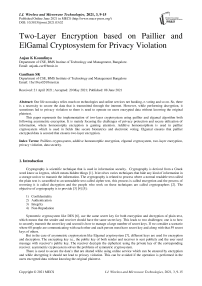Two-Layer Encryption based on Paillier and ElGamal Cryptosystem for Privacy Violation
Автор: Anjan K. Koundinya, Gautham S.K.
Журнал: International Journal of Wireless and Microwave Technologies @ijwmt
Статья в выпуске: 3 Vol.11, 2021 года.
Бесплатный доступ
Our life nowadays relies much on technologies and online services net banking, e-voting and so on. So, there is a necessity to secure the data that is transmitted through the internet. However, while performing decryption, it sometimes led to privacy violation so there is need to operate on users encrypted data without knowing the original plaintext. This paper represents the implementation of two-layer cryptosystem using paillier and elgamal algorithm both following asymmetric encryption. It is mainly focusing the challenges of privacy protection and secure utilization of information, where homomorphy encryption is gaining attention. Additive homomorphism is used in paillier cryptosystem which is used in fields like secure biometrics and electronic voting. Elgamal ensures that paillier encrypted data is secured that ensures two-layer encryption.
Pailliers cryptosystem, additive homomorphic encryption, elgamal cryptosystem, two-layer encryption, privacy violation, data security
Короткий адрес: https://sciup.org/15017679
IDR: 15017679 | DOI: 10.5815/ijwmt.2021.03.02
Список литературы Two-Layer Encryption based on Paillier and ElGamal Cryptosystem for Privacy Violation
- Alfred J. Menezes and Paul C. van Oorschot and Scott A. Vanstone: “Handbook of Applied Cryptography”, pp. 1- 2, August 1996
- Mohammed, Abdalbasit & Varol, Nurhayat. (2019). A Review Paper on Cryptography. 1-6. 10.1109/ISDFS.2019.8757514.
- Stallings, William. (2003). Cryptography and Network Security: Principles And Practices.
- Sobti, Rajeev & Ganesan, Geetha. (2012). Cryptographic Hash Functions: A Review. International Journal of Computer Science Issues, ISSN (Online): 1694-0814. Vol 9. 461 - 479.
- Khalifa, Othman & Islam, Md & Khan, Sheroz & Shebani, M.S.. (2004). Communications cryptography. 220 - 223. 10.1109/RFM.2004.1411111.
- U.S. DEPARTMENT OF COMMERCE/National Institute of Standards and Technology, “Data Encryption Standard”.
- T. Elgamal, "A public key cryptosystem and a signature scheme based on discrete logarithms," in IEEE Transactions on Information Theory, vol. 31, no. 4, pp. 469-472, July 1985, doi: 10.1109/TIT.1985.1057074.
- Paillier P. (1999) Public-Key Cryptosystems Based on Composite Degree Residuosity Classes. In: Stern J. (eds) Advances in Cryptology — EUROCRYPT ’99. EUROCRYPT 1999. Lecture Notes in Computer Science, vol 1592. Springer, Berlin, Heidelberg. https://doi.org/10.1007/3-540-48910-X_16.
- Suwandi, Rifki & Nasution, Surya & Azmi, Fairuz. (2018). Secure E-voting System by Utilizing Homomorphic Properties of the Encryption Algorithm. Telkomnika (Telecommunication Computing Electronics and Control). 16. 862-867. 10.12928/TELKOMNIKA.v16i2.8420.
- Catalano, Dario & Gennaro, Rosario & Howgrave-Graham, Nick. (2001). The Bit Security of Paillier's Encryption Scheme and Its Applications.. 229-243.
- Balasubramanian, K. and Jayanthi, M. (2016) A Homomorphic Crypto System for Electronic Election Schemes. Circuits and Systems, 7, 3193-3203. doi: 10.4236/cs.2016.710272.
- Dan Boneh, Eu-Jin Goh, and Kobbi Nissim. 2005. Evaluating 2-DNF formulas on ciphertexts. In i Proceedings of the Second international conference on Theory of Cryptography i (iTCC'05/i). Springer-Verlag, Berlin, Heidelberg, 325–341. DOI:https://doi.org/10.1007/978-3-540-30576-7_18.
- ElGamal T. (1985) A Public Key Cryptosystem and a Signature Scheme Based on Discrete Logarithms. In: Blakley G.R., Chaum D. (eds) Advances in Cryptology. CRYPTO 1984. Lecture Notes in Computer Science, vol 196. Springer, Berlin, Heidelberg. https://doi.org/10.1007/3-540-39568-7_2


